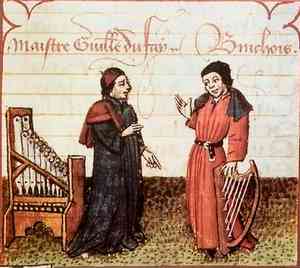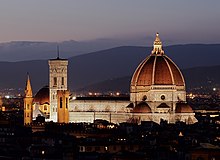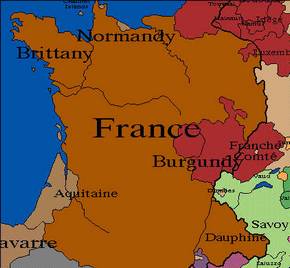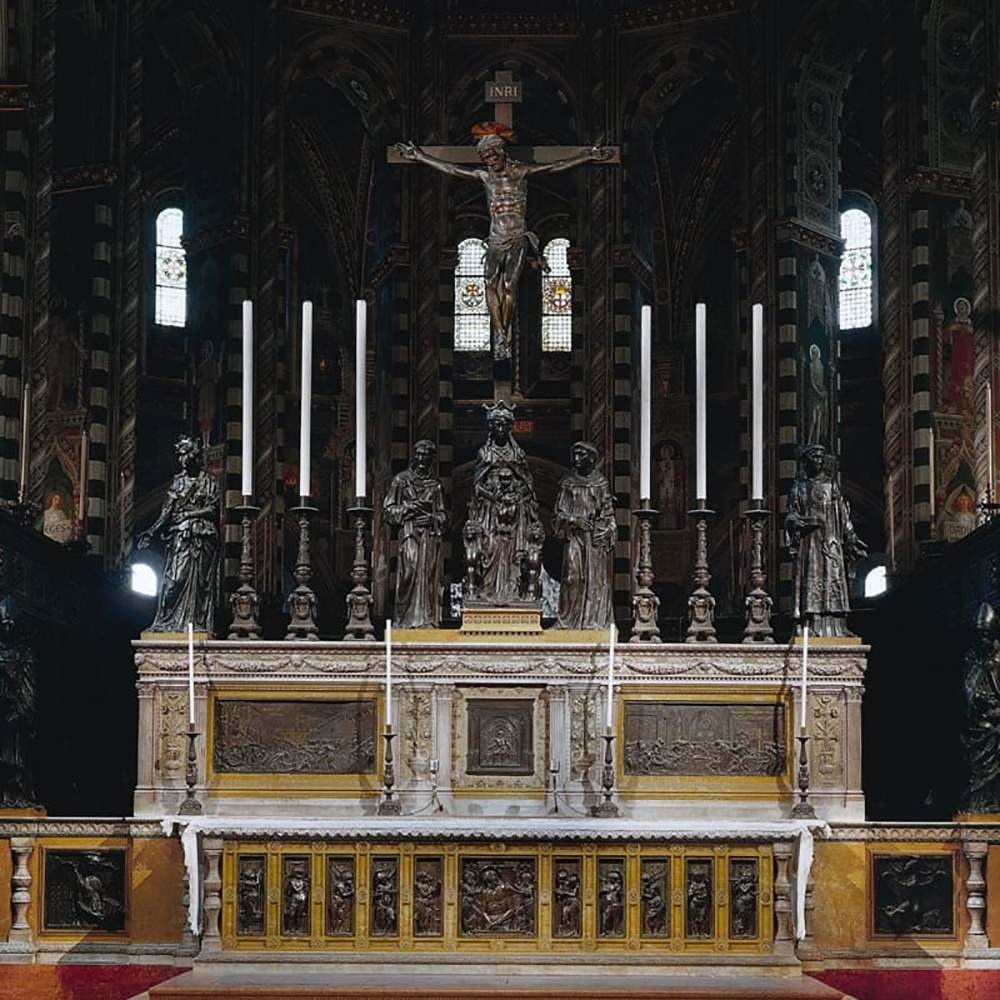


Guillaume DuFay w Gilles Binchois 1451
Source:
Wikipedia
Born in Beersel near Brussels (Belgium) possibly on 5 August 1397, Guillaume Dufay (alt: Du Fay) was the illegitimate son of an unknown priest and a woman name Marie Du Fay (alt: Du Fayt). He bridges medieval music to thisoe musical renaissance as probably the most popular composer of the 15th century. In sacred music it will have been nigh two and a half centuries since Leonin and Perotin founded the Notre Dame school of polyphony when DuFay began composing. In secular forms, the love songs of the troubadours had been around as long to influence DuFay. His friend above is another Burgundian composer, Gilles Binchois, born only slightly later and whose career paralleled DuFay's.
DuFay spent his entire life from childhood onward in Cambrai in northern France, minus extended periods of residency or travel to other locations in both France and Italy. Serving as a choir boy during adolescence, DuFay was only age sixteen when he was made chaplain by benefice at St. Géry in Cambrai as he studied beneath Nicolas Malin and Richard Loqueville. He became subdeacon at the Cambrai Cathedral in 1418. In 1420 he left Cambrai for Rimini, Italy, before securing patronage from the Malatesta family in Pesaro.
DuFays earliest compositions traced to 1420, his first may have been ‘Vasilissa, ergo gaude’ ('Therefore Rejoice, Princess'), an isorhythmic motet composed for the rather high society wedding on 21 January 1421 of Cleofa Malatesta to Theodore II Palaiologos, son of Byzantine Emperor, Manuel II Palaiologos. Isorhythm ("same rhythm") is a termed coined in 1904 by musicologist, Friedrich Ludwig, to describe a compositional form in which a tenor line is repeated by a talea line, a method evolving out of the Notre Dame school of polyphony in the latter 13th century and common by DuFay's time, particularly among the works of Phillipe de Vitry (1291-1361) and Guillaume de Machaut (c 1300-1377). Though uncertain, DuFay's ballade, 'J'ay mis mon cuer et ma pensée', may have been composed for another great wedding in 1425, that of Elisabetta Malatesta da Rimini to Piergentile Varano [Oxford Music Online].
'Vasilissa, ergo gaude' Isorhythmic motet for 4 voices by Guillaume Dufay 1420
Text from Psalm 45:11
Huelgas Ensemble directed by Paul Van Nevel
'J'ay mis mon cuer et ma pensée' Ballade for 3 voices by Guillaume Dufay possibly 1425
Medieval Ensemble of London
Another type of motet that DuFay practiced was the cantilena, a secular song style imported to the Continent from England imbued with devotional texts. Machaut, above, had earlier also applied himself to the cantilena. The popular 'Virgene Bella' below was probably written in Italy some time in the twenties, that a setting for the last poem in Petrarch's 'Il Canzoniere' written circa 1327 to 1368. 'Virgene Bella' is the second known setting of a poem by Petrarch. The first was 'Non al suo amante' by Jacopo da Bologna circa 1350 during Petrarch's lifetime.
'Vergene Bella' Cantilena motet for 3 voices by Guillaume Dufay c 1420-1429 in Italy
Text from Petrarch's last poem in 'Il Canzoniere'
Mignarda w lute by Ron Andrico
DuFay wrote numerous secular chansons (songs). He was back north in Cambrai in 1426 when he composed the rondeau, 'Adieu ces bons vins de Lannoys 'Goodbye to the Fine Wines of Lannoys':
'Adieu ces bons vins de Lannoys' Rondeau by Guillaume Dufay 1426
Ensemble Unicorn conducted by Michael Posch Countertenor: Bernhard Landauer
Returning to Italy in 1428, DuFay become a priest in Bologna, then went to Rome to become a member and master in the Papal Choir. 'Flos Florum' is another cantilena motet composed about that time:
'Flos Florum' Cantilena motet by Guillaume Dufay c 1430
Vokalensemble Pro Musica w the Instrumental Ensemble conducted by Johannes Hömberg 1974
Another form practiced by DuFay was the faux bourdon (false drone) applied to plainchant, also found in his isorhythmic and cantilena motets. Unlike the latter, the faux bourdon is thought to have originated with DuFay as a means of investing cantus firmus (pre-existing melodies) with another part a sixth interval below and a third a perfect fourth. DuFay's earliest use of faux bourdon with a certain date is the isorhythmic motet for four voices, 'Supremum est mortalibus', traced to 1433.
'Supremum est mortalibus' Fauxbourdon method in isorhythmic motet by Guillaume Dufay 1433
Huelgas Ensemble directed by Paul Van Nevel
Continuing a double life of service to both the Church and wealthy patrons, in 1434 DuFay was appointed chapel master by Duke Amédée VIII in Savoy, France. Savoy was another of DuFay's important haunts, continuing after the death of Amédée in 1451. It was 1936 when he composed the motet, 'Nuper rosarum flores' ('The Rose Flowers Recently') toward the consecration of Brunelleschi's dome atop the Florence Cathedral on 25 March 1436. As for the papal court, it was removed to Bologna in April 1436 where by 1437 DuFay acquired a law degree, probably by fiat of the Pope since his name isn't found in university documents. Between those two events. DuFay had also found patronage with the Este family in Ferrara, Italy, during the thirties.

Dome of the Florence Cathedral Brunelleschi 1436
Source:
Wikipedia
'Nuper rosarum flores' Isorhythmic motet for 4 voices by Guillaume Dufay 1436
Written for the consecration of the Florence Cathedral
Hilliard Ensemble conducted by Paul Hillier 1987
DuFay's 'Ave Maris Stella' ('Hail, Star of the Ocean') of circa 1440 further illustrates DuFay's usage of faux bourdon. The original 'Ave Maris Stella' has been traced to sometime in the 9th century by an anonymous composer, two copies of which exist in Vienna and the Abbey of St. Gall. Another example of faux bourdon is 'Vexilla regis prodeunt' for which melody by one anonymous DuFay probably wrote the text on a date unknown.
'Ave Maris Stella' Fauxbourdon method by Guillaume Dufay c 1440
Composition: Anonymous 9th century
Pomerium conducted by Alexander Blachly 1998
'Vexilla regis prodeunt' Fauxbourdon method by Guillaume Dufay Date unknown
Composition: Anonymous w text by DuFay
Pro Musica Antiqua directed by Safford Cape 1954
It was about 1440 when DuFay entered into the service of the Duke of Burgundy. Thusly did DuFay became a founder of the Burgundian School. The Burgundian School is of major significance in the history of classical music as the wellspring to the early musical Renaissance even as its expansion into the greater Franco-Flemish School would pour into the Renaissance for another century and half. DuFay's 'Seigneur Leon' is thought to have been written in 1442 toward the accession of Leonello d’Este to Marquis of Ferrara (Italy).

Burgundy - Fountain of the musical Renaissance
'Seigneur Leon' Rondeau by Guillaume Dufay 1442
Written toward the occasion of Leonello d’Este becoming Marquis of Ferrara
From 'Triste Plaisir' by Lena Susanne Norin, Randall Cook & Susanne Ansorg Denmark 2006
Continuing a double life between service to the Church and royalty, Dufay became a canon of St. Waudru in Mons in 1447. His 'Mass for St. Anthony of Padua' is dated to 1450 as it was possibly composed for that year's dedication in June of Donatello's altar in the basilica of Padua.

Donatello's altar in the Basilica di Sant'Antonio in Padua 1450
Source: Web Gallery of Art
Offertorium to the 'Mass for St Anthony of Padua' by Guillaume Dufay 1450
Pomerium conducted by Alexander Blachly
The latter years of DuFay's life were spent in Turin, Savoy and Cambrai. Composing for above half a century, his works include 87 motets, 66 French or Italian chansons and 8 complete masses. He also wrote antiphons and Magnificats. The 'Magnificat' is a canticle, that is, a hymn which lyrics are borrowed from the Bible. The 'Magnificat' quotes Mary, mother of Jesus, in 'Luke' 1:46-55, which text would be set to music countless times through centuries to come. In the Eastern Orthodox Church 'Magnificat' is known as the 'Ninth Ode' or, 'Song of the Theotokos'. It isn't known when DuFay authored 'Magnificat quinti toni' ('Magnificat Fifth Scale') for three voices with a faux bourdon setting.
'Magnificat quinti toni' Fauxbourdon method for 3 voices by Guillaume Dufay Date unknown
Boston Church of the Advent Choir 2015
By the time of his passing on 27 November 1474 DuFay had become the most influential composer in Europe due that he had long since become its most popular. Generally credited as father of the musical Renaissance among composers of the Burgundian School, the greater Franco-Flemish School to come would supply the Renaissance with music throughout its period.
Sources & References for Guillaume DuFay:
VF History (notes)
Audio:
The Burgundian School (associated composers)
The Franco-Flemish School (associated composers)
Audio of DuFay:
Mass for St. Anthony of Padua (1450 / by Pomerium)
Vergene Bella (c 1420-29 / by various)
The Burgundian School:
The Burgundian School (video)
The Cantilena (musical style): Britannica
The Cantilena Motet: Julie E. Cumming (The Motet in the Age of Du Fay / Cambridge U Press 2003)
Compositions by DuFay: Corpus:
Compositions by DuFay: Forms:
Compositions by DuFay: Individual:
Adieu ces bons vins de Lannoys (1426): Donato Mancini Music Salon
Ave Stella Maris (c 1440):
Our Lady of Solitude Monastery
Mass for St Anthony of Padua (1450):
Peter Woetmann Christoffersen (2019)
F. D. Leone (2017)
Oxford University Press (1998)
Nuper rosarum flores (1436): Wikipedia
Vasilissa ergo gaude (1420): Wikipedia
Vergene Bella (c 1420-29):
LiederNet (text in English)
David J. Rothenberg (The Flower of Paradise / Oxford University Press 2011)
The Fauxbourdon (liturgical musical form): Britannica Wikipedia
The Magnificat (Luke 1:46-55): Britannica New Advent Wikipedia
Composers of the Magnificat: Wikipedia
Ninth Ode (Orthodox Church):
Orthodox Church of the Mother of God
Recordings of DuFay: Catalogs:
Medieval Music & Arts Foundation
Recordings of DuFay: Select:
Guillaume Dufay (including Magnificat quinti toni by the Boston Choir of the Church of the Advent)
Sacred Music From Bologna - 915 (The Clerks Group directed by Edward Wickham 2000)
Scores:
Flos Florum (c 1430)
IMSLP
Magnificat Quinti Toni (year of composition unknown)
Vasilissa ergo gaude (1420)
Musicalics
Vergene Bella (c 1420-29): CPDL Musescore
Usage of DuFay in Soundtracks: IMDb
Bibliography:
Willem Elders (Guillaume Dufay's Concept of Faux-Bourdon / Revue belge de Musicologie Vol 43 1989)
Charles Edward Hamm (A Chronology of the Works of Guillaume Dufay / Princeton U Press 1964/2015)
David J. Rothenberg (The Flower of Paradise / Oxford University Press 2011)
Authority Search:
Other Profiles:
Study (subscription)
Classical Main Menu Modern Recording
hmrproject (at) aol (dot) com